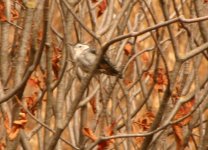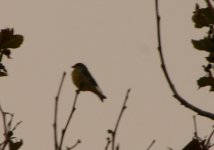Granville Leong
Well-known member
Hi All,
I have just started out in bird photography. I'm encountering two recurring problems. One is soft focus and the other is the bird is too dark on a cloudy day. My shutter speed is at a minimum 1/125. Aperture is 8 or 11. If I change the aperture to a lower number, the shutter speed goes up; but I prefer to a shallower background, so I keep the aperture at 8. ISO is 800 on a cloudy day. Camera is Canon Digital Rebel, the vintage DSLR. Lens is Tamron 28 to 300mm.
Also, is the autofocus process controlled by the camera or the lens?
I'm attaching two pictures. The first one clearly shows that the focus is way too soft. The second one shows my on-going problem of not having enough light on the bird.
Can anyone suggest ways for me to improve? Thanks in advance for the help.
Granville
I have just started out in bird photography. I'm encountering two recurring problems. One is soft focus and the other is the bird is too dark on a cloudy day. My shutter speed is at a minimum 1/125. Aperture is 8 or 11. If I change the aperture to a lower number, the shutter speed goes up; but I prefer to a shallower background, so I keep the aperture at 8. ISO is 800 on a cloudy day. Camera is Canon Digital Rebel, the vintage DSLR. Lens is Tamron 28 to 300mm.
Also, is the autofocus process controlled by the camera or the lens?
I'm attaching two pictures. The first one clearly shows that the focus is way too soft. The second one shows my on-going problem of not having enough light on the bird.
Can anyone suggest ways for me to improve? Thanks in advance for the help.
Granville





